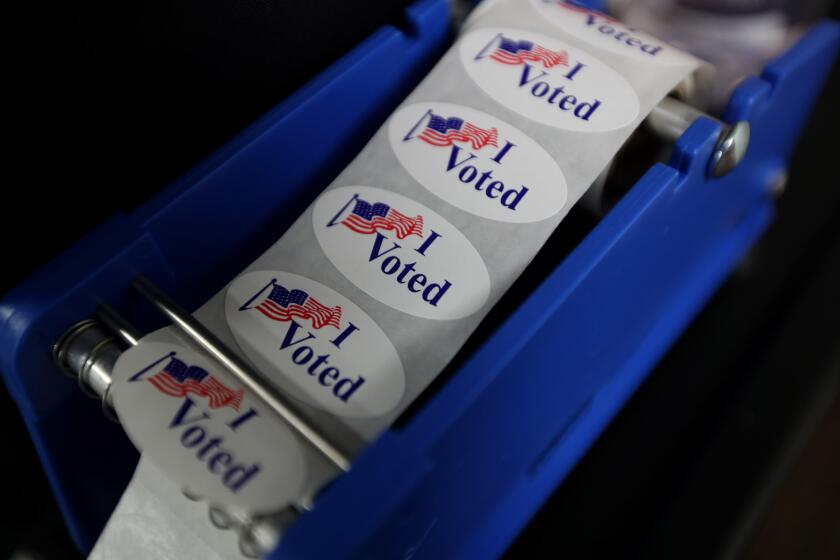Bush Outlines $10-Billion Plan for Job Training
- Share via
UNION, N.J. — Seeking to blunt opposition to a new free trade agreement with Mexico and Canada, President Bush on Monday called for $10 billion in new federal spending to create and expand a host of job training programs.
The five-year program, a major domestic initiative, would nearly triple the federal bankroll to help U.S. workers adjust to a changing world economy. It would also swell the Civilian Conservation Corps to accommodate an additional 43,000 disadvantaged youth.
Bush has portrayed his reelection campaign as a crusade for lower taxes and lower federal spending. But he offered no explanation as to how he intended to offset the annual cost of $2 billion for his job plan.
Instead, he used the plan as a bludgeon to attack Democratic nominee Bill Clinton, whose own job training proposal requires large companies to spend 1.5% of their payroll on training or pay an equivalent amount into a national job training fund.
Speaking to students and faculty at a technical institute here, Bush contended that his rival would fund such programs “out of your paycheck.”
Bush’s lack of specificity on how to pay for his own job training plan provoked new cries of outrage from the Clinton campaign, which has charged that Bush cannot meet his promises to cut both taxes and spending. A top Clinton official said the White House appeared hopeful “that a secret plan to balance the budget and cut taxes is going to fool the American people.”
The training plan was Bush’s third proposal in five days that would require offsetting spending cuts in unspecified programs. In his Republican National Convention speech, the President proposed across-the-board tax cuts if spending cuts could be found, and a tax-form checkoff plan to let Americans designate up to 10% of their income taxes to reduce the national debt.
Clinton’s communication director, George Stephanopolous, said of Bush’s job training proposal: “Imitation is the sincerest form of flattery. But how is he going to pay for it?”
Bush acknowledged in his address here that the program would “cost money.” But he indicated that he would wait until early next year for outlining spending cuts, and aides insisted that the proposal remains consistent with his campaign posture.
“The President never said he didn’t want some programs to go up,” said Thomas Scully, associate director of the Office of Management and Budget. “He said he wanted spending to go down.”
The Bush proposal appeared to go a long way toward addressing Democratic objections to the proposed North American Free Trade Agreement. Congressional Democratic leaders have said they want to see its job-training and environmental provisions before agreeing to it--as has Clinton. Early in the primaries, Clinton supported the pact’s negotiation.
The White House has refused to forecast how many workers might lose their jobs as a result of the free trade pact and instead has tried to emphasize that the agreement will, on balance, create more jobs than it will eliminate. But the trade agreement’s critics warn that it will eventually eliminate hundreds of thousands of high-paying manufacturing jobs, and Monday’s job retraining announcement was a tacit acknowledgment that the free trade agreement could prove costly to large segments of the American work force.
The program sets aside $2 billion a year to provide skilled training assistance for workers whose jobs are put at risk by the free trade agreement or by broader changes in the economy. Administration officials said the program would be sufficient to provide for as many as 1.2 million workers.
The plan, which would replace a program offering $770 million a year in aid, would provide grants of up to $3,000 a year to help dislocated or at-risk workers enroll in technical schools or other job training programs.
Bush’s proposal, while on a smaller scale than Clinton’s, appears to be more narrowly focused. Clinton’s plan is designed to provide broad incentives for continuing education for working Americans; Bush’s program is targeted at providing training and income support for the jobless.
Apart from his effort to reassure critics of the trade agreement, Bush clearly sought to use the job training plan as an emblem of what has become a campaign theme: that foreign and domestic policy are inextricably linked--and that Bush is best equipped to manage them.
“We know the world economy is changing,” he said, “and America must change with it.”
He described the worker adjustment initiative as a way to help Americans “caught in the transition of the economy.”
Labor Secretary Lynn Martin described the job training as the “flip side” of job creation. And as if to underscore concern about the economy, the White House chose to couple its announcement of the plan with its unveiling of a separate initiative aimed at young Americans.
Of his programs, the most far-reaching would create a youth training corps aimed at the disadvantaged. Its members would be housed at 25 new residential centers under the supervision of former military personnel for a curriculum that would include basic job training and work on parks, recreation and community facilities.
The new program, whose $200-million first-year cost would rise to $385 million by 1996, would nearly double the number of young people given job training under the current job corps.
Until now, the White House had resisted plans by Clinton and other Democrats calling for a widened conservation corps. But Bush made clear that he remained opposed to his rivals’ plans, deriding their proposals as “make-work alternatives.”
Times staff writer James Risen contributed to this story.
DOLLAR BATTERED: The sagging greenback pulled world stock markets down. D1
More to Read
Get the L.A. Times Politics newsletter
Deeply reported insights into legislation, politics and policy from Sacramento, Washington and beyond. In your inbox twice per week.
You may occasionally receive promotional content from the Los Angeles Times.










